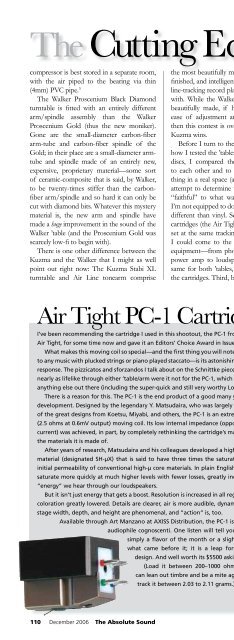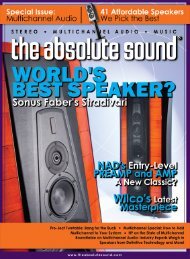Create successful ePaper yourself
Turn your PDF publications into a flip-book with our unique Google optimized e-Paper software.
The Cutting Edge<br />
compressor is best stored in a separate room,<br />
with the air piped to the bearing via thin<br />
(4mm) PVC pipe. 3<br />
The Walker Proscenium Black Diamond<br />
turntable is fitted with an entirely different<br />
arm/spindle assembly than the Walker<br />
Proscenium Gold (thus the new moniker).<br />
Gone are the small-diameter carbon-fiber<br />
arm-tube and carbon-fiber spindle of the<br />
Gold; in their place are a small-diameter armtube<br />
and spindle made of an entirely new,<br />
expensive, proprietary material—some sort<br />
of ceramic-composite that is said, by Walker,<br />
to be twenty-times stiffer than the carbonfiber<br />
arm/spindle and so hard it can only be<br />
cut with diamond bits. Whatever this mystery<br />
material is, the new arm and spindle have<br />
made a huge improvement in the sound of the<br />
Walker ’table (and the Proscenium Gold was<br />
scarcely low-fi to begin with).<br />
There is one other difference between the<br />
Kuzma and the Walker that I might as well<br />
point out right now: The Kuzma Stabi XL<br />
turntable and Air Line tonearm comprise<br />
the most beautifully machined, professionally<br />
finished, and intelligently ergonomic straightline-tracking<br />
record player I’ve seen or played<br />
with. While the Walker is also beautiful and<br />
beautifully made, if high-tech sexiness and<br />
ease of adjustment are your first priorities,<br />
then this contest is over before it starts. The<br />
Kuzma wins.<br />
Before I turn to the sound, let me tell you<br />
how I tested the ’tables. First, using the same<br />
discs, I compared the Kuzma and Walker<br />
to each other and to the sound of the real<br />
thing in a real space (as I hear it). I made no<br />
attempt to determine which ’table was more<br />
“faithful” to what was on the mastertapes.<br />
I’m not equipped to do that; plus, tapes sound<br />
different than vinyl. Second, I used identical<br />
cartridges (the Air Tight PC-1) in both arms,<br />
set at the same tracking force and as near as<br />
I could come to the same VTA. All other<br />
equipment—from phonostage to preamp to<br />
power amp to loudspeakers—remained the<br />
same for both ’tables, as did the loading of<br />
the cartridges. Third, both ’tables were seated<br />
Air Tight PC-1 Cartridge<br />
I’ve been recommending the cartridge I used in this shootout, the PC-1 from the Japanese firm<br />
Air Tight, for some time now and gave it an Editors’ Choice Award in Issue 165.<br />
What makes this moving coil so special—and the first thing you will note about it if you listen<br />
to any music with plucked strings or piano played staccato—is its astonishingly realistic transient<br />
response. The pizzicatos and sforzandos I talk about on the Schnittke piece wouldn’t have been<br />
nearly as lifelike through either ’table/arm were it not for the PC-1, which is audibly faster than<br />
anything else out there (including the super-quick and still very worthy London Reference).<br />
There is a reason for this. The PC-1 is the end product of a good many years of research and<br />
development. Designed by the legendary Y. Matsudaira, who was largely responsible for some<br />
of the great designs from Koetsu, Miyabi, and others, the PC-1 is an extremely low-impedance<br />
(2.5 ohms at 0.6mV output) moving coil. Its low internal impedance (opposition to the flow of<br />
current) was achieved, in part, by completely rethinking the cartridge’s magnetic structure and<br />
the materials it is made of.<br />
After years of research, Matsudaira and his colleagues developed a high-µ core and winding<br />
material (designated SH-µX) that is said to have three times the saturation flux-density and<br />
initial permeability of conventional high-µ core materials. In plain English, the PC-1’s magnets<br />
saturate more quickly at much higher levels with fewer losses, greatly increasing the sense of<br />
“energy” we hear through our loudspeakers.<br />
But it isn’t just energy that gets a boost. Resolution is increased in all regards—and noise and<br />
coloration greatly lowered. Details are clearer, air is more audible, dynamics are more lifelike,<br />
stage width, depth, and height are phenomenal, and “action” is, too.<br />
Available through Art Manzano at AXISS Distribution, the PC-1 is already a hit among<br />
audiophile cognoscenti. One listen will tell you why. The PC-1 isn’t<br />
simply a flavor of the month or a slight improvement over<br />
what came before it; it is a leap forward in moving-coil<br />
design. And well worth its $5500 asking price.<br />
(Load it between 200–1000 ohms—at 47k, the PC-1<br />
can lean out timbre and be a mite aggressive on top. And<br />
track it between 2.03 to 2.11 grams.) JV<br />
on top of the same<br />
massive platform—<br />
Lloyd Walker’s 450-<br />
pound, rock-maple,<br />
shot-loaded, Valid-<br />
Point-tipped Prologue Reference equipment<br />
stand—which was carefully leveled, fore<br />
and aft. The only variable in setup—and<br />
it was unavoidable—were the tonearm<br />
interconnects. The Kuzma comes with singleended<br />
Cardas interconnects hard-wired to the<br />
tonearms leads; the Walker has RCA outputs<br />
at the back of its plinth, to which you attach<br />
interconnects of your choice (in this case,<br />
Tara Labs “Zeros”).<br />
Since both record players showed the same<br />
sets of virtues on every record I played—no<br />
matter what kind of music or how large the<br />
ensemble—I am going to try something a<br />
bit different in this review. I am going to talk,<br />
primarily, about how well each turntable let<br />
me hear one representative piece of music,<br />
Alfred Schnittke’s Quasi una sonata [EMI]—a<br />
brilliant post-Modernist caprice for violin<br />
and piano that is extraordinarily dynamic,<br />
extraordinarily rich and nuanced in tone color,<br />
and extraordinarily well-recorded.<br />
First a bit about the piece itself. In Schnittke’s<br />
words, Quasi una sonata “is a report on the<br />
impossibility of the sonata in the form of a<br />
sonata.” It begins with a tremendous crashing<br />
G minor chord played sforzando (suddenly, with<br />
great force) on the piano, followed after a long<br />
moment of silence by a rippingly dissonant<br />
chord played sforzando on the violin—tonality<br />
and atonality (the twin poles of twentiethcentury<br />
music) deliberately pitted against each<br />
other at the top of each instrument’s voice,<br />
like a shouting match between, say, Samuel<br />
Barber and Arnold Schoenberg.<br />
As the piece goes on, these two kinds<br />
of music are stated and restated at<br />
different dynamic levels and with different<br />
articulations, like the “themes” and tonal<br />
centers of a traditional sonata. Yet despite<br />
constant attempts to set them in joint musical<br />
motion—including an adagio ironically<br />
based on the classic B-A-C-H motive and a<br />
fugue also ironically based on the classic B-<br />
A-C-H motive—the two musics refuse to be<br />
reconciled. No matter how loudly or softly<br />
the instruments play or what manner they<br />
play in—and they are played in every form of<br />
staccato and legato known to man, making for<br />
a stunningly virtuosic sonic exercise—musical<br />
momentum keeps breaking down.<br />
To make musical sense of Quasi una sonata,<br />
a record player has, first and foremost, to<br />
capture realistically the unusual timbres that<br />
are at the heart of this argument between<br />
the tonal and the atonal; while doing this, it<br />
110 December 2006 The Absolute Sound










